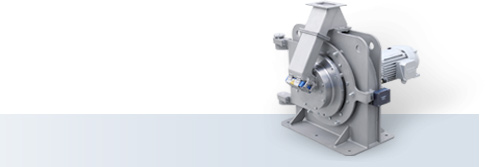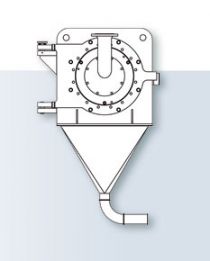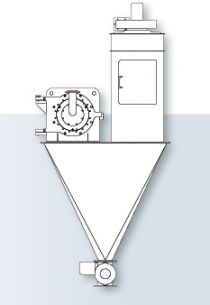Turbo Mill GWH

The crushing mechanism of the turbo mill is based on a combination of screenless impact crushing and a secondary effect. The impact crushing takes place through the impact of the mill feed on rotor tools and stator segments. The secondary effect is through autogenous crushing (particle against particle) caused by the extreme turbulence in the milling chamber.
Turbo mills are used in a wide variety of applications from fine grinding of all types of soft and medium-hard materials to coating of powders, grind drying and the fiberisation of various products.
Advantages
- Easy adjustment of the refiner gap from 0.5 to 5 mm through the conical rotor and moveable stator.
- Ultra-fine powder. Due to the strong design and precise manufacturing standards, it is possible to achieve circumferential speeds of up to 160 m/s. Due to the constant refiner gap over the whole length, the milled product is very fine.
- High efficiency. Very good power consumption: throughput ratio.
- Low wear and tear due to the use of highly wear-resistant materials and hardening processes.
- Simple plant layout. In many applications it is possible to eliminate complex and expensive systems such as classifier mills or beater mills with subsequent classifiers.
- Robust casing made of welded steel or stainless steel.
- Direct drive. This places a lower radial load on the bearings and significantly increases the operating life. Due to the use of a frequency converter, the rotor speed (r.p.m.) and therefore the fineness of the product are infinitely adjustable.
- A wide range of applications: micronisation, deagglomeration, fine grinding of temperature-sensitive products, cryogenic milling, selective grinding of composite materials, mill drying, coating, fiberisation of cellulose (e.g. paper) for producing insulation materials, . . .
Advantages of horizontal turbo mill


After the product exits the refiner gap in the vertical version, it enters a ring chamber and from there it is suction extracted tangentially. With difficult products, caking can build up in the ring chamber.
In the horizontal version, the mill feed passes into a wide chamber casing. The air speed is reduced considerably, which prevents caking on the wall of the casing. The milled product then falls unhindered through the opening in the bottom of the housing. From there it can be suction extracted over an exhaust funnel or it can fall into a collection bin. Together with a top filter for the collection bin, positioned alongside it and a rotary discharge valve, the result is a simple and cost-effective grinding plant that requires no suction extraction of the product.
In the horizontal version, access to the milling chamber and grinding tools is via a pivoting door and has thus been simplified considerably. This also significantly reduces service and cleaning times.
A further advantage of the horizontal design is that the rotor can rotate in both directions. The grinding tools can therefore wear on both sides and tool life is increased. In contrast, the tangential product extraction technique used in the vertical model only functions in one rotational direction. In this case, the grinding tools must be replaced when just one side of the rotor is worn.
